On one of my last trips I visited Nepal to film and photograph meditation sessions in addition to extending my work visa for Thailand, the latter reason why due to a setback I finally had to extend my stay in the country of Buddha’s birth. Thus, after finishing my work with the meditation sessions in Kathmandu, it turned out that I suddenly had two extra days in the country, so without thinking twice and despite being twelve hours away by bus, I bagged my camera and I packed my backpack and headed to the mystical place that stars in one of the Heroes of Silence songs, the Lakes of Pokhara.
I was told that most tourists choose taxis as a means of transportation and others choose a high-end bus, but I, true to my style, traveled the way the locals do, which in this case was a dumpy bus. . I arrived at night after a travel odyssey along mountain roads and walked directly to the lake in order to be in position to fulfill the objective for which I had traveled to Pokhara: to photograph the lakes at sunrise and sunset from the best possible location.


As always, I put the responsibility of my task in the hands of local wisdom, asking several native inhabitants who agreed that without a doubt the best place to place my camera was the top of Mount Sarangkot, located on the edge of Lake Phewa. So, I found a cheap room in the last hostel on the street next to the lake bordering the base of the mountain and after sleeping for about four hours, at three in the morning I was already up to begin my challenge and try to reach the summit located at 1,700 meters high in time to photograph the lakes at dawn.
The locals had told me there was a way up, as well as provided some basic instructions. Even so, I also asked some truck drivers who were already awake at that time and they told me the direction I should follow to climb the mountain more or less peacefully along the path that led directly to the top.
However, it was totally dark, I only had the light of the cell phone that I borrowed for my work in Thailand and, as I started to climb the mountain, the path forked in several directions, so I followed my instinct, I chose one of them and I started to climb. After an hour of climbing with a medium difficulty in the dense darkness of the night, I began to realize that I was not climbing the path, as gradually the path became more complicated and the undergrowth became thicker and thicker. But it was too late to turn back, because if I did I wouldn’t reach the top in time to photograph the sunrise and that would mean losing my challenge with the mountain, so I continued climbing guided by my intuition and the faint light emanating from the stars. , as well as sometimes the cell phone light…which gradually ran out of battery.
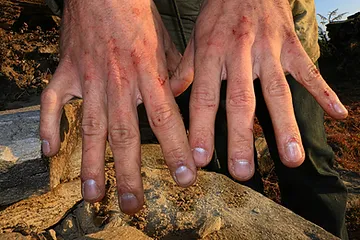

Bloody hands after the night climb
The slope became steeper and the undergrowth turned into sharp brambles that trapped me, scratched me and made each step a real struggle. I was lost in the middle of the night in the middle of the mountain just guessing where the top was. My hands were bleeding, my energy was running out and the summit seemed to be further and further away. As if that were not enough, every time I stopped the undergrowth moved a few meters away from me, giving the impression that it could be some wild animal lurking. Thus, I began to delirious and conceive my challenge as if it were a metaphor for life turned into a lesson: when everything is darkness, the slightest ray of light can illuminate just enough to see the path; Sometimes one step back serves to take several steps forward in an accurate way; Every time you fall and get up you feel stronger but you are also closer to not having the strength to get up again, and, above all, what path is called everything that takes us to our destination.
I had already been climbing for three hours and a certain clarity was beginning to appear in the sky, warning that the sun was on its way to attend its daily appointment with the dawn. I no longer had any battery in my phone and I was climbing practically blind, fighting with my bare, bleeding hands to break down the walls of brambles that stood in my way. And every time I stopped, something shook suddenly in the undergrowth behind me… I was completely devastated, I thought I was totally lost, when finally the path cleared up giving way to a field of pine forests that I practically trot up out of excitement and after which I finally managed to see the top of the mountain, which was at a more than considerable distance, although the path was clear. Empty of strength, I was proud and arrived just a few minutes early to place my camera and save the energy necessary to press the shutter and photograph the lakes at dawn. Half the task was done, now we had to go down and photograph at sunset.
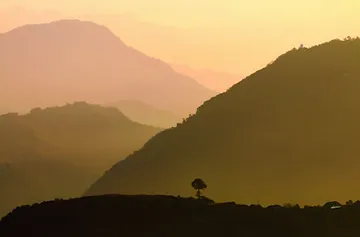

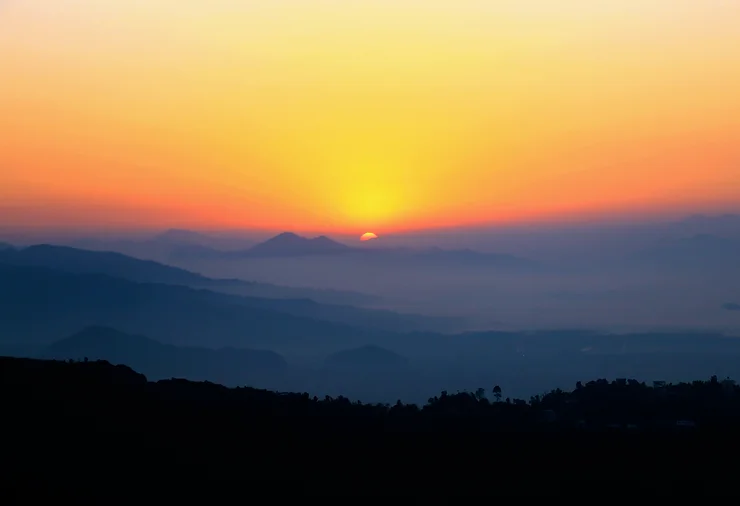

The climb was worth it, the sunrise over the Annapurna mountains was amazing
When descending, from the top and with the morning light, I clearly saw the path that the locals indicated and with which I would have gone much more peacefully, but it no longer mattered, my path had taken me to my destination on time, then It was equally valid.
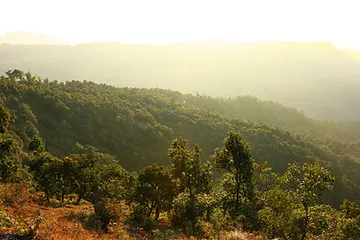

While I was going down, I met two young Nepalese people who, seeing me covered in dirt and branches, bleeding and heartless, took me to their house to invite me to tea in the presence of their parents and grandmother. When they asked me what had happened to me and I showed them where I had gone up, they snorted and said that I was totally crazy, not only for going up in the dark on the most complicated side, but especially because on that certain mountain there was a tiger famous for annihilating animals. of the farmers.
When my face fell at the news, they insisted to me several times that it was not a very big tiger, but I couldn’t stop thinking about the bushes shaking a few meters away from me every time I stopped or fell to the ground. Was it the little tiger waiting for me to lower my arms and become easy prey? Any other much more harmless animal? Or the imagination of locals providing adrenaline to this adventure? There will never be a way to know, although my experience tells me that the locals usually know what they are saying.
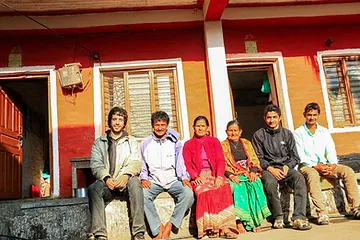

A Nepalese family took pity on me
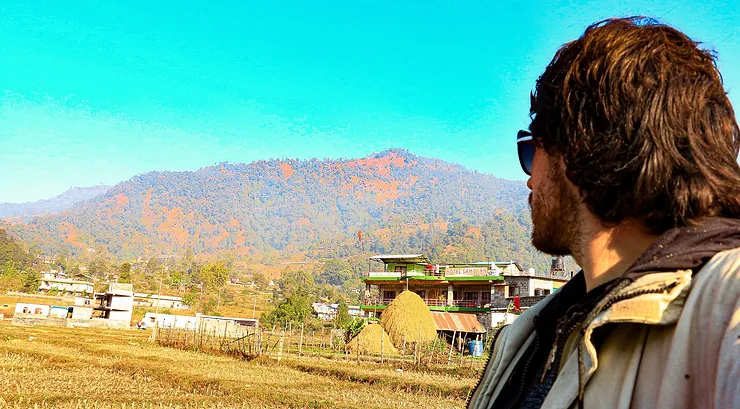

Last look at Mount Sarangkot, thanking you for the adventure
The day was spent trying to rest and regain some strength, although when I got into position to photograph the sunset, I was still completely devastated. Furthermore, I had hardly any money (I didn’t expect to spend three more days in the country, having to buy two bus tickets and pay for a night in a hostel) and I had hardly eaten. At that moment, a woman of about sixty years old appeared with a small sheet full of necklaces. After a couple of minutes trying to sell me her crafts and realizing that she was absent due to my condition, she started to ask me what had happened to me and we started talking and getting intimate. It turned out that she was a Tibetan woman who could not visit her family because China denied her the opportunity to return to her hometown. Thus, the woman, while she told me her personal story with anger and tears in her eyes, kept repeating often, “you know? China bullshit!” (You know, China is stupid!).
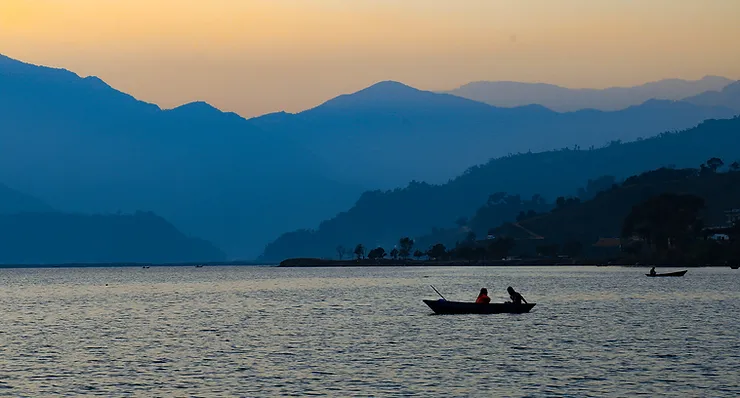

The lakes of La Certera at sunset
After listening to his story, I put my hand in my pocket and placed all the coins and bills I had on the floor, barely reaching four dollars. The woman, who when she arrived was asking me for twelve and fifteen dollars for her necklaces, gave me one of them, telling me that it was the only one that really came from Tibet, since she made it before she was deported. Tibet. We said goodbye with a hug and when she was gone, the woman retraced her steps and gave me a bag of nuts that she had in her backpack while saying the last words I would hear from her: “as a mother I want to think that my children are safe and sound, so I want your mother, who also has you away, to be calm that you are fed.”
Thus was born the promise to pay off my debt with that beautiful woman: I would go to Tibet to investigate and learn about the situation as well as fight for its people using the two most powerful weapons I know, my camera and the truth. It was there that my next adventure was forged, in Pokhara, photographing the Lakes of Certainty at sunset.
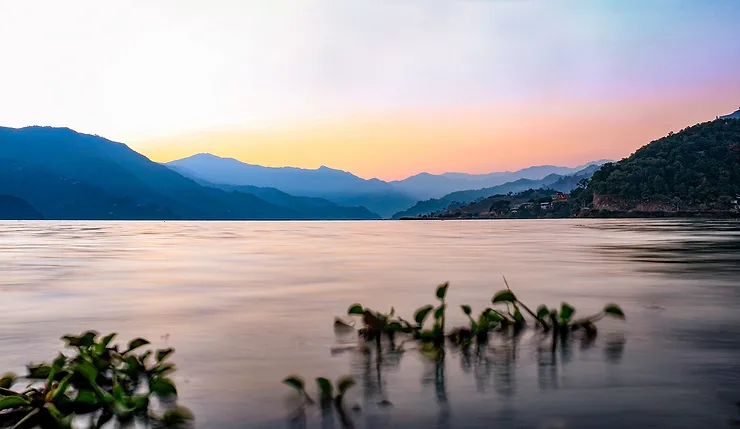

In the lakes of Certera my next documentary project was forged: Still Tibet
Update: Two years later, my documentary Still Tibet would be screened around the world, win the jury’s special mention award at the Bolivian Human Rights Festival, and is currently being broadcast on national American television.
